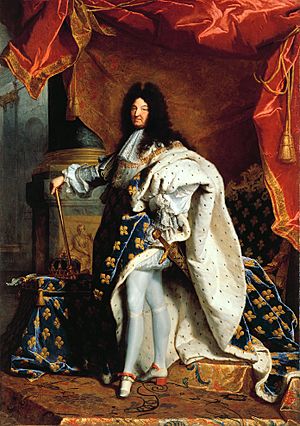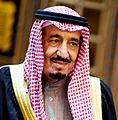Absolute monarchy facts for kids

An absolute monarchy is a type of government where one person, usually a monarch (like a king or queen), holds all the power. This means they can make all the decisions without anyone else telling them what to do. They are not limited by laws or other groups of people.
This is very different from a constitutional monarchy. In a constitutional monarchy, the monarch's power is limited. It might be limited by a written constitution, a parliament, or other important groups.
For a long time, many kings and queens had absolute power. This was especially true during the Middle Ages. But after events like the French Revolution in the late 1700s, things started to change. More and more countries began to limit their monarchs' power with constitutions.
Today, there are only a few absolute monarchies left in the world. Most of them are in Arab and Middle Eastern countries.
Contents
What is an Absolute Monarchy?
An absolute monarchy is a system where the ruler has complete control. This ruler, often called a king, queen, or emperor, makes all the laws. They also decide how the country is run. There are no other groups, like a parliament or a court, that can stop them.
How is it Different?
It's important to know that an absolute monarchy is not the only type of monarchy.
- In an absolute monarchy, the monarch has total power. They rule alone.
- In a constitutional monarchy, the monarch's power is limited. They might share power with a parliament. Or they might mostly be a symbol for the country, like in the United Kingdom.
A Look Back in Time
Absolute monarchies were very common for many centuries. They shaped how countries were governed for a long time.
Kings and Queens of the Past
During the Middle Ages, most rulers in Europe were absolute monarchs. They believed their right to rule came directly from God. This idea was called "divine right." It meant that no one could question their power. They controlled everything from laws to taxes and armies.
The French Revolution's Impact
The French Revolution in the late 1700s changed a lot of things. People started to demand more say in how they were governed. This led to many countries moving away from absolute rule. They began to create constitutions that limited the power of their monarchs. This was a big step towards more modern forms of government.
Absolute Monarchies Today
While absolute monarchies are rare now, a few still exist. These countries continue to have rulers with full power. They are mostly found in the Middle East.
Images for kids
-
Salman, King of Saudi Arabia and Custodian of the Two Holy Mosques
See also
 In Spanish: Monarquía absoluta para niños
In Spanish: Monarquía absoluta para niños


